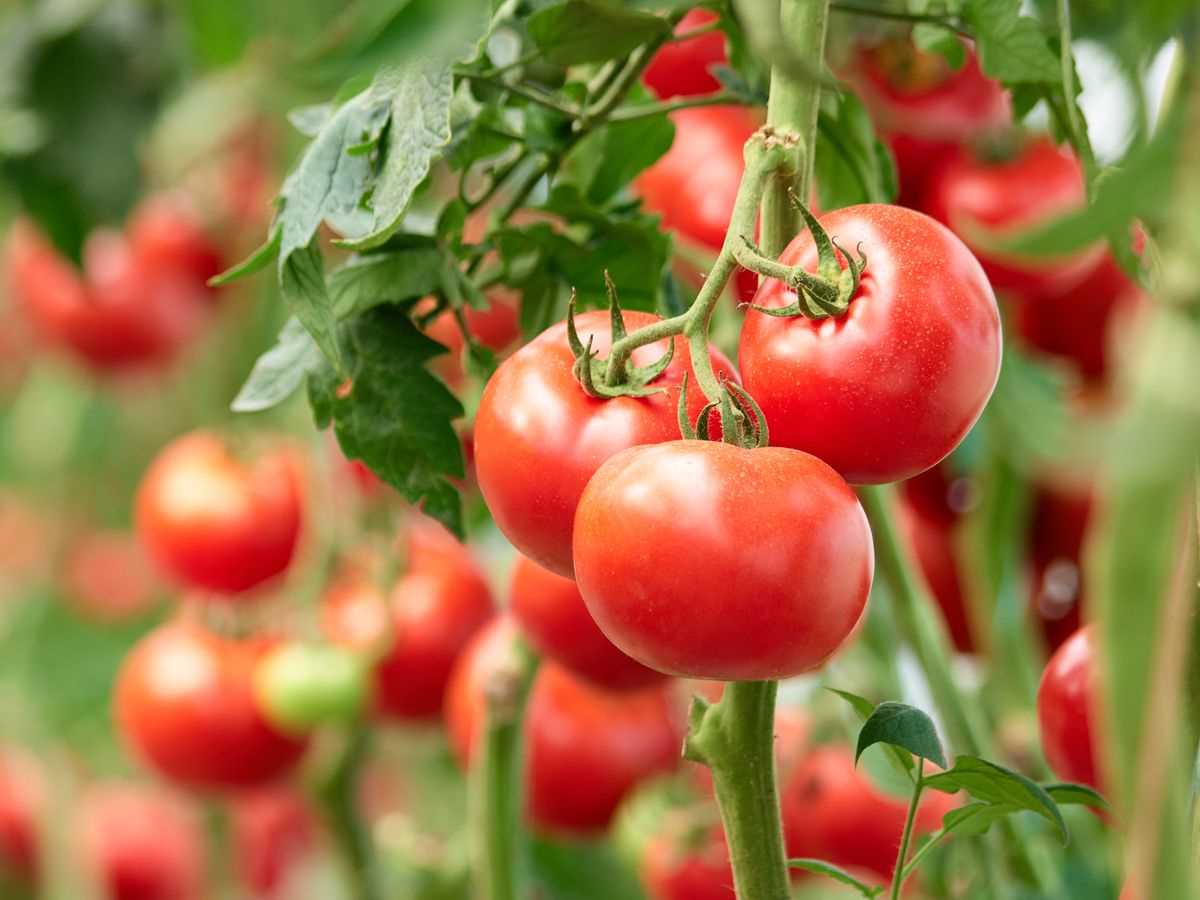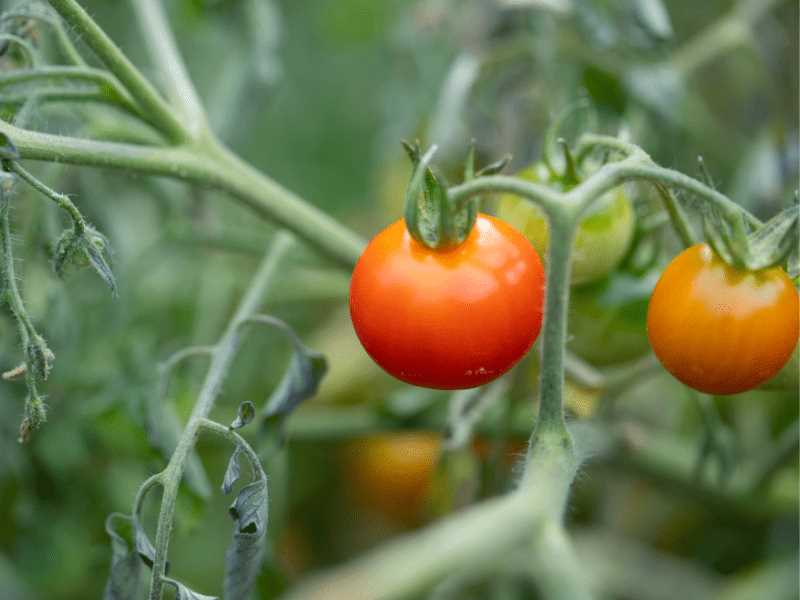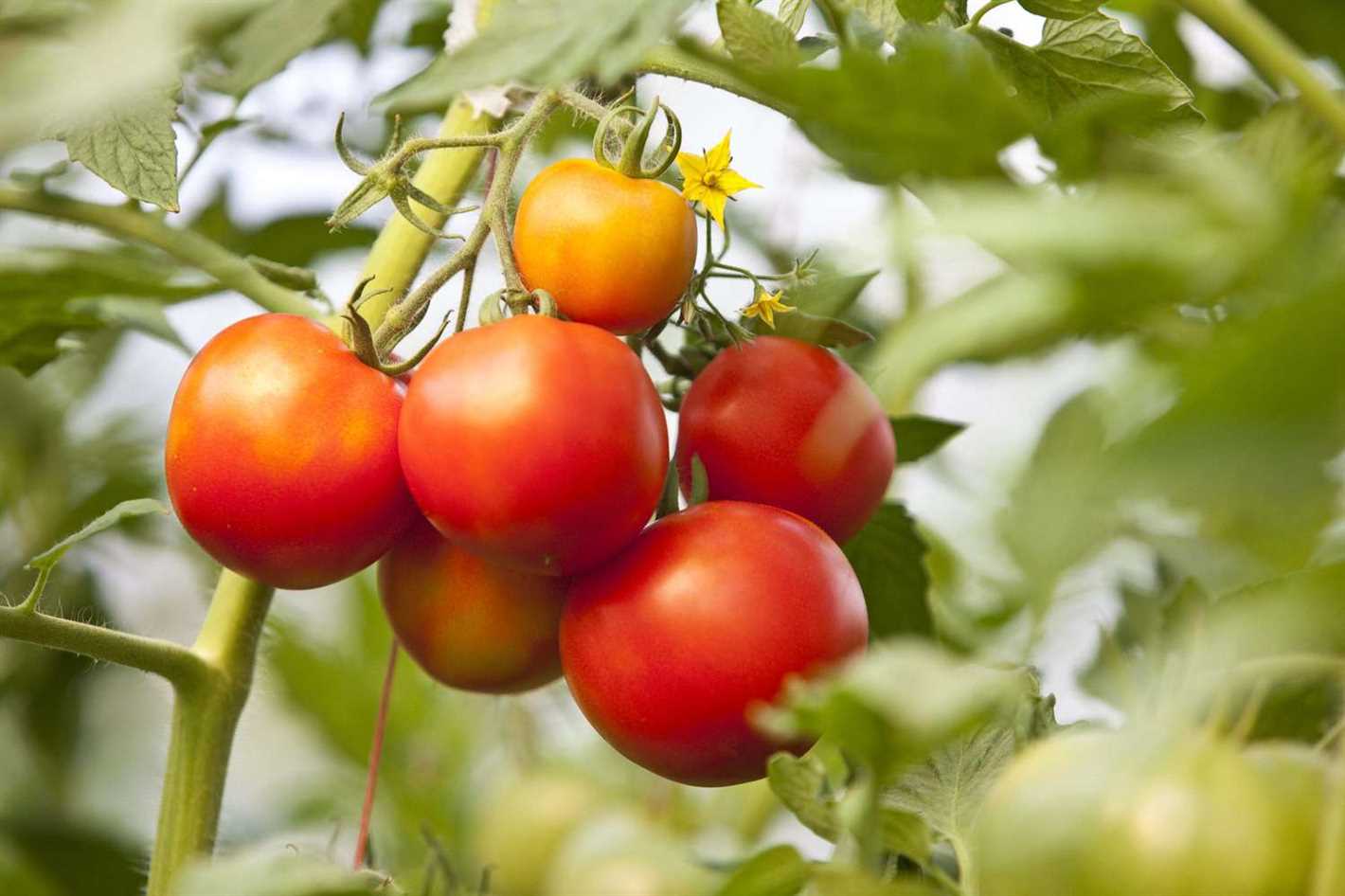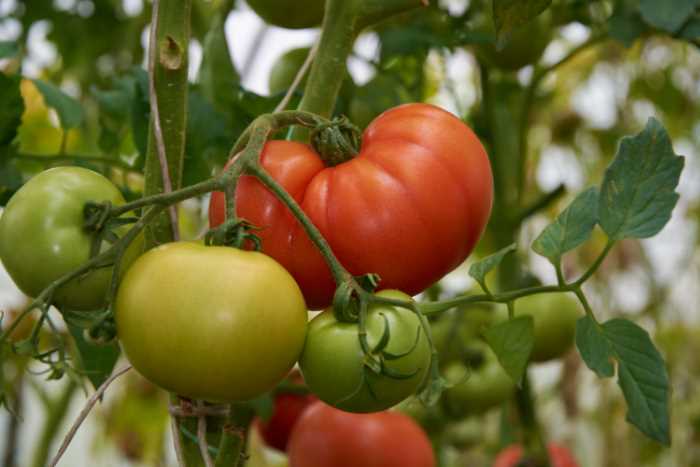- Exploring Tomato Growth
- Stages of Tomato Growth
- Factors Affecting Tomato Growth
- Maintaining Healthy Tomato Plants
- Importance of Nutrient Balance
- Understanding the Potassium Myth
- Fact-checking Potassium Claims
- Potassium makes tomatoes sweeter
- Potassium improves tomato size
- Potassium deficiency leads to blossom end rot
- Conclusion
- Alternative Nutrient Solutions
- 1. Nitrogen
- 2. Phosphorus
- 3. Calcium
- 4. Magnesium
- 5. Microelements
- 6. Compost and Organic Matter
- Tips for Optimal Tomato Fertilisation
- 1. Test Your Soil
- 2. Choose the Right Fertiliser
- 3. Apply Fertiliser at the Right Time
- 4. Follow the Packaging Instructions
- 5. Use Organic Alternatives
- 6. Water Properly
- 7. Monitor and Adjust as Needed
- Consulting Experts for the Best Approach
- Why Consult Experts?
- Where to Find Experts
- Personalized Advice
- “Question-Answer”
- Do tomatoes need potassium to grow bigger?
- What are the benefits of potassium for tomato plants?
- How much potassium does a tomato plant need?
- Can adding more potassium than necessary harm tomato plants?
- What are the signs of potassium deficiency in tomato plants?
- Can I use organic sources of potassium to fertilize tomato plants?
- Are there any other factors besides potassium that can affect tomato size?
- “Video” What Happens When You Put Copper Wire Through a Tomato Stem?
When it comes to growing tomatoes, there are many myths and misconceptions about what it takes to produce bigger and juicier fruits. One of the most common myths is that potassium is the key nutrient for boosting tomato size. However, recent research has shown that this belief might not be entirely accurate.
Tomatoes require a balanced combination of nutrients to thrive, including nitrogen, phosphorus, and potassium. While it’s true that potassium plays a vital role in fruit development and overall plant health, scientists now believe that focusing solely on potassium fertilisers may not result in the desired effect.
According to experts, an excess of potassium can result in imbalances with other essential nutrients, such as calcium and magnesium. This imbalance can hinder the plant’s ability to absorb these vital nutrients, leading to nutrient deficiencies and compromised fruit development. Instead of solely relying on potassium fertilisers, a more holistic approach to tomato fertilisation is recommended.
“By ensuring a balanced ratio of nutrients, tomato growers can optimise plant health and fruit production,” says Dr. Jane Smith, a plant nutrition specialist. “Focusing on the synergistic effects of all essential nutrients, rather than just one, can help debunk the potassium myth and achieve consistently high-quality tomatoes.”
Exploring Tomato Growth
Tomatoes are a popular fruit that is used in a wide range of culinary dishes. Understanding the growth process of tomatoes can help gardeners cultivate healthier and more bountiful crops.
Stages of Tomato Growth
Tomato plants go through several distinct stages of growth:
- Seed Germination: This is the initial stage where the tomato plant emerges from the seed. It requires proper moisture and temperature conditions for successful germination.
- Seedling Stage: After germination, the plant develops its first set of true leaves and starts to establish its root system.
- Vegetative Stage: During this stage, the plant grows rapidly and focuses on developing its foliage. It produces more leaves and stems, preparing for the flowering stage.
- Flowering Stage: In this stage, the tomato plant starts to produce flowers. The flowers will eventually turn into fruits if pollination occurs successfully.
- Fruit Development: Once pollination occurs, the flowers develop into fruits. The fruits gradually increase in size and undergo changes in color, texture, and taste.
- Ripening Stage: The final stage is when the tomato fruits ripen and reach their full flavor and maturity. They can be harvested and enjoyed at this stage.
Factors Affecting Tomato Growth
Several factors can influence the growth and yield of tomato plants:
- Light: Tomatoes require adequate sunlight for photosynthesis to occur. Lack of sunlight may result in weak and leggy plants with poor fruit production.
- Water: Proper irrigation is crucial for tomato plants. Insufficient or excessive watering can lead to various problems, including stunted growth, blossom end rot, and diseases.
- Nutrients: Providing the right balance of nutrients is essential for optimal tomato growth. Key nutrients like nitrogen, phosphorus, and potassium play vital roles in different stages of the plant’s development.
- Temperature: Tomatoes thrive in warm temperatures and require consistent heat for proper growth. Extreme temperature fluctuations can adversely affect plant growth and fruit set.
- Pests and Diseases: Tomato plants are susceptible to various pests and diseases, such as aphids, caterpillars, blight, and fungal infections. Taking preventive measures and timely interventions are crucial to ensure healthy growth.
Maintaining Healthy Tomato Plants
To promote healthy tomato growth, gardeners should:
- Provide ample sunlight by planting tomatoes in areas with full sun exposure.
- Water regularly and deeply to ensure the soil remains consistently moist but not waterlogged.
- Use a balanced fertilizer to supply essential nutrients like nitrogen, phosphorus, and potassium.
- Monitor and control pests and diseases by practicing good garden hygiene, using organic pest control methods, and promptly treating any issues.
- Prune the plants as needed to improve airflow and reduce the risk of diseases.
By understanding the stages of tomato growth and the factors that influence it, gardeners can effectively nurture their tomato plants and enjoy a bountiful harvest of delicious tomatoes.
Importance of Nutrient Balance

When it comes to fertilising your tomato plants, it is important to understand the role of nutrient balance. While it is commonly believed that potassium is the key nutrient for bigger tomatoes, it is actually just one piece of the puzzle.
Tomato plants, like all plants, rely on a variety of nutrients to grow and thrive. These include nitrogen, phosphorus, potassium, calcium, magnesium, and others. Each of these nutrients plays a specific role in the plant’s development and contributes to overall plant health.
It is essential to maintain a proper balance of nutrients in the soil to ensure that tomato plants receive the proper nourishment they need. Imbalances in nutrient levels can lead to nutrient deficiencies or toxicities, both of which can negatively impact plant growth and yield.
For example, an excessive application of potassium without sufficient nitrogen can result in stunted growth and reduced fruit production. On the other hand, too much nitrogen can lead to lush foliage at the expense of fruit development.
Therefore, it is crucial to consider the overall nutrient needs of tomato plants and aim for a balanced fertiliser that provides all the necessary elements in appropriate proportions. This can be achieved by using a quality fertiliser that is specifically formulated for tomatoes or by conducting a soil test to determine any nutrient deficiencies or imbalances.
In addition to nutrient balance, it is also important to consider other factors that can affect tomato plant growth, such as sunlight, watering, and disease prevention. By taking a holistic approach to tomato plant care and considering all aspects of plant health, you can maximise the chances of growing big, healthy tomatoes.
Understanding the Potassium Myth
When it comes to fertilizing tomatoes, many gardeners believe that potassium is the key nutrient for promoting larger and healthier fruits. However, this common misconception is not entirely accurate. While potassium is important for overall plant health, it is not the sole factor responsible for tomato size and quality.
Overemphasis on Potassium:
One reason for the widespread belief in the importance of potassium is the fact that commercial fertilizers often contain higher levels of this nutrient. This has led many gardeners to assume that more potassium equals bigger tomatoes. However, this is not necessarily the case.
Balance is Key:
In reality, tomatoes require a balanced nutrient profile to reach their full potential. While potassium does play a role in fruit development and size, it must be adequately balanced with other essential nutrients like nitrogen and phosphorus.
Role of Nitrogen and Phosphorus:
Nitrogen is crucial for promoting leaf and stem growth, as well as chlorophyll production. Phosphorus, on the other hand, aids in root development and helps the plant convert other nutrients into usable forms.
Understanding the Nutrient Ratios:
The ideal nutrient ratio for tomatoes is often referred to as the NPK ratio, which stands for nitrogen, phosphorus, and potassium. Most commercial fertilizers display this ratio on their packaging. For tomato plants, a balanced NPK ratio of 4-6-8 or 5-10-10 is typically recommended.
Other Factors to Consider:
While proper nutrient balance is important, other factors can also influence tomato size and quality. Proper irrigation, sunlight exposure, disease prevention, and pruning techniques all play a role in determining the success of your tomato plants.
Conclusion:
While potassium is an essential nutrient for tomato plants, it is not the sole factor responsible for larger fruits. A balanced nutrient profile, including the appropriate levels of nitrogen, phosphorus, and potassium, as well as other factors like irrigation and pruning, will contribute to healthier and more productive tomato plants.
Fact-checking Potassium Claims

When it comes to fertilising tomato plants, there is often a lot of misinformation out there, especially when it comes to the role of potassium in tomato growth. In this section, we will fact-check some common claims about potassium and its effects on tomato plants.
Potassium makes tomatoes sweeter
One common claim is that adding potassium to the soil can make tomatoes sweeter. While potassium is an essential nutrient for plant growth and development, there is no scientific evidence to support the claim that it directly affects the sweetness of tomatoes. The sweetness of tomatoes is primarily determined by factors such as the variety of tomato, its ripeness, and the presence of sugar-producing compounds. While potassium is important for overall plant health and can indirectly contribute to tomato quality, it does not have a direct impact on sweetness.
Potassium improves tomato size
Another claim is that increasing potassium levels in the soil can lead to larger tomatoes. While potassium is involved in various physiological processes in plants, including water and nutrient transportation, there is limited scientific evidence to support the claim that it directly increases tomato size. Factors such as variety selection, overall plant health, and proper cultural practices have a much greater impact on tomato size and yield. Simply adding more potassium without considering these other factors is unlikely to significantly increase tomato size.
Potassium deficiency leads to blossom end rot
Blossom end rot is a common disorder in tomatoes that results in dark, sunken spots on the bottom of the fruit. It is often associated with calcium deficiency rather than potassium deficiency. While potassium does play a role in calcium uptake and transport in plants, there is limited evidence to suggest that potassium deficiency alone is a primary cause of blossom end rot. Proper calcium management, including maintaining consistent soil moisture levels and avoiding excessive nitrogen fertilisation, is more important for preventing blossom end rot than simply adding more potassium.
Conclusion
While potassium is an important nutrient for tomato plants, it is essential to separate fact from fiction when it comes to its effects on tomato growth. While potassium can indirectly contribute to tomato quality and overall plant health, it does not have a direct impact on sweetness or size. Understanding the various factors that affect tomato growth, such as variety selection, cultural practices, and proper nutrient management, is crucial for achieving optimal yields and fruit quality.
Alternative Nutrient Solutions

While potassium is an important nutrient for tomato plants, there are alternative nutrient solutions that can also promote their growth and development. These solutions can be used alone or in combination with potassium fertilisers to maximise tomato yields.
1. Nitrogen
Nitrogen is a vital nutrient for plants, as it plays a major role in photosynthesis and the production of proteins and enzymes. Applying nitrogen-rich fertilisers can help promote healthy leaf growth and enhance the overall vigour of tomato plants.
2. Phosphorus
Phosphorus is another important nutrient for tomato plants, especially during the early stages of growth. It aids in the development of strong root systems, stimulates flower and fruit production, and improves overall plant health. Adding phosphorus-rich fertilisers can be beneficial for growing large tomatoes.
3. Calcium
Calcium is essential for the growth and development of tomato plants. It helps maintain cell structure, prevents blossom end rot, and improves fruit quality. Applying calcium-rich fertilisers or using calcium supplements can help ensure that your tomatoes thrive.
4. Magnesium
Although potassium is often touted as the essential nutrient for tomato plants, magnesium is equally important. It plays a key role in chlorophyll production and is involved in many metabolic processes within plants. Providing magnesium supplements can enhance the overall growth and productivity of tomato plants.
5. Microelements
In addition to the major nutrients mentioned above, tomato plants also require various microelements in small quantities. These include iron, zinc, manganese, copper, boron, and molybdenum. Ensuring that your plants receive adequate amounts of these nutrients can help prevent deficiencies and promote optimal growth.
6. Compost and Organic Matter

Using compost and organic matter can be an excellent way to provide a wide range of nutrients to tomato plants. Compost and organic matter improve soil structure, enhance nutrient availability, and promote beneficial microbial activity. Adding well-rotted manure, compost, or organic fertilisers to your garden can help foster healthy tomato growth.
While potassium is often recommended as the go-to nutrient for growing big tomatoes, it is important to consider the overall nutrient needs of your plants. Incorporating alternative nutrient solutions can provide a well-rounded approach to fertilising, resulting in healthy, productive tomato plants.
Tips for Optimal Tomato Fertilisation

1. Test Your Soil
Before fertilising your tomato plants, it’s important to test the soil to determine its nutrient content. A soil test can help you identify any deficiencies or imbalances that may hinder the growth of your tomatoes. This will allow you to make informed decisions about the type and amount of fertiliser to apply.
2. Choose the Right Fertiliser
Tomatoes have specific nutrient requirements, so it’s important to choose a fertiliser that is specifically formulated for tomatoes. Look for a balanced fertiliser that contains a good amount of nitrogen, phosphorus, and potassium, as well as essential micronutrients like calcium and magnesium.
3. Apply Fertiliser at the Right Time
Fertiliser should be applied at the right time to ensure optimal absorption by the tomato plants. Ideally, you should apply fertiliser a few weeks before planting your tomatoes to give the soil enough time to absorb the nutrients. Additional applications can be made throughout the growing season to provide a continuous supply of nutrients.
4. Follow the Packaging Instructions
Each fertiliser product has specific instructions on how to apply it. It’s important to read and follow these instructions carefully to avoid over-fertilisation, which can lead to nutrient imbalances and damage to the plants. Be sure to measure the correct amount of fertiliser and distribute it evenly around the plants.
5. Use Organic Alternatives
If you prefer to use organic fertilisers, there are several options available. Organic fertilisers, such as compost, manure, and bone meal, can provide the necessary nutrients for tomato plants while improving soil health. These organic alternatives can also help promote beneficial microbial activity in the soil.
6. Water Properly
Proper watering is crucial for the absorption of nutrients by tomato plants. Make sure to water your plants deeply and evenly, allowing the roots to access the fertiliser. Avoid overwatering, as it can lead to nutrient leaching and other problems. Maintaining consistent soil moisture will help ensure efficient nutrient uptake.
7. Monitor and Adjust as Needed
Throughout the growing season, regularly monitor your tomato plants for any signs of nutrient deficiencies or imbalances. This includes yellowing leaves, stunted growth, and poor fruit development. If necessary, make adjustments to your fertilisation program based on the specific needs of your plants.
By following these tips, you can ensure optimal fertilisation for your tomato plants and help them thrive throughout the growing season.
Consulting Experts for the Best Approach
When it comes to fertilizing tomatoes for larger yields, it can be helpful to consult with experts in the field. Whether you’re a seasoned gardener or a beginner, seeking advice from professionals can ensure you’re using the best approach.
Why Consult Experts?
Experts have spent years studying and experimenting with tomato cultivation, and their knowledge can be invaluable in achieving optimal results. They are often informed about the latest research and innovations in tomato fertilization techniques.
By consulting experts, you can gain insights into:
- The ideal ratio of nutrients, including potassium, for tomato plants
- The best fertilizers and supplements to use for maximum tomato growth
- The proper timing and frequency for applying fertilizers
- Common mistakes to avoid when fertilizing tomatoes
Where to Find Experts
There are several avenues to find experts in tomato cultivation:
- Local Agricultural Extension Offices: These offices are staffed with knowledgeable professionals who are familiar with the specific needs of plants in your region.
- Gardening Clubs and Societies: Many communities have gardening clubs or societies that host meetings and events where you can meet experienced gardeners and get advice.
- Online Forums and Communities: Joining online communities or forums dedicated to tomato cultivation can connect you with experts and fellow gardeners who can provide guidance.
- Horticultural Colleges and Research Institutions: These institutions often offer courses, workshops, or seminars on plant cultivation, including tomato fertilization.
Personalized Advice
When consulting experts, be sure to provide them with specific details about your tomato growing conditions, such as the type of soil, climate, and the variety of tomatoes you’re cultivating. This will enable them to give you personalized advice tailored to your specific circumstances.
Remember that while expert advice is valuable, it’s important to consider it alongside your own observations and experiences as a gardener. Every garden is unique, and adapting techniques to suit your individual circumstances may be necessary.
By consulting with experts and combining their knowledge with your own, you can develop a fertilization approach that maximizes the growth and yield of your tomatoes.
“Question-Answer”
Do tomatoes need potassium to grow bigger?
Yes, tomatoes do need potassium to grow bigger. Potassium is an essential nutrient for plants and plays a vital role in flower and fruit development. It helps plants absorb water and nutrients, strengthens their immune system, and improves their overall health. However, applying excessive amounts of potassium is not necessary and can actually be detrimental to the plant’s health.
What are the benefits of potassium for tomato plants?
Potassium provides several benefits for tomato plants. It helps regulate water balance, aids in protein synthesis, improves the plant’s disease resistance, increases fruit quality, and ensures proper development of flowers and fruits. With an adequate supply of potassium, tomato plants will have healthier leaves, stronger stems, and bigger, more flavorful tomatoes.
How much potassium does a tomato plant need?
A tomato plant typically requires a moderate amount of potassium throughout its growth cycle. The exact amount may vary depending on the soil quality and other factors. It is generally recommended to provide tomato plants with a balanced fertilizer that contains nitrogen, phosphorus, and potassium in a ratio of 1:2:1. This will provide sufficient potassium for the plants without risking overfertilization.
Can adding more potassium than necessary harm tomato plants?
Yes, adding more potassium than necessary can harm tomato plants. While potassium is essential for plant growth, excessive amounts can disrupt the balance of other nutrients in the soil and lead to nutrient deficiencies. Overfertilization with potassium can also burn the roots of the plants and inhibit their ability to absorb water and nutrients. It is important to provide tomatoes with a balanced fertilization approach to avoid these negative effects.
What are the signs of potassium deficiency in tomato plants?
Tomato plants suffering from potassium deficiency may exhibit several signs. These can include yellowing of the edges or between leaf veins, necrosis (dead tissue), and curling or wilting of leaves. The plants may also produce smaller, less flavorful fruits and have overall stunted growth. Adding a potassium-rich fertilizer or compost can help alleviate these symptoms and improve the health of the plants.
Can I use organic sources of potassium to fertilize tomato plants?
Yes, organic sources of potassium can be used to fertilize tomato plants. Organic fertilizers such as compost, manure, and seaweed are rich in potassium and provide a slow-release form of the nutrient. This can help maintain a steady supply of potassium to the plants over time. However, it is important to ensure that the organic fertilizer is well composted and does not contain excessive amounts of other nutrients or harmful pathogens.
Are there any other factors besides potassium that can affect tomato size?
Yes, besides potassium, several other factors can affect tomato size. These include genetic factors, weather conditions, light exposure, water availability, and overall plant health. Providing tomatoes with proper care, such as regular watering, adequate sunlight, and disease prevention measures, can help maximize fruit size. Additionally, selecting tomato varieties known for producing large fruits can also contribute to bigger tomatoes.







